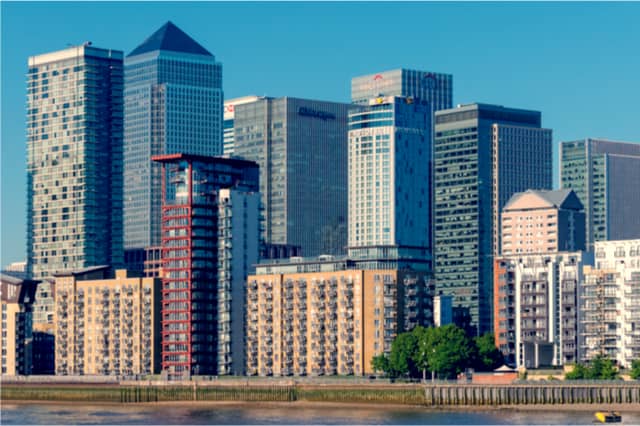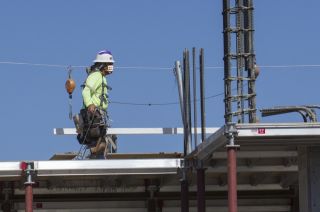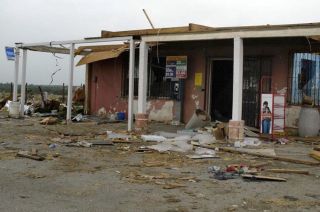
www.buildingsandcities.org/insights/commentaries/pandemics-why-buildings-are-hazards.html
Pandemics: Why Buildings are Hazards

Wastewater systems in tall buildings are a transmission pathway for pathogens. Despite robust evidence (and clear solutions), standards, codes and regulations have failed to respond and present a public health risk.
Michael Gormley (Heriot Watt University) explains a neglected area of public health and building design: the plumbing systems for wastewater. What can building designers and regulators can do to reduce the hazard of disease transmission in tall buildings?
Lessons from SARS
The SARS outbreak in 2002/2003 lasted only 4 months had 8,000 cases and claimed the lives of 775 worldwide. This seems a paltry number of deaths given that since December 2019 the total number of lives claimed by COVID-19, caused by the SARS-CoV-2 virus is reported to be 265,000 (as of 7th May). The characteristics which have contributed to this are that SARS had a much higher mortality rate and a much lower R0 (the reproductive rate of a disease - the average number of people who will catch the disease from a single infected person). This means that a higher percentage of people who contracted SARS died but it didn't spread as rapidly as COVID-19. SARS vanished in June 2003 and has not been seen since.
In many ways SARS (and MERS which followed) should have been a wake-up call to our modern globalised world that a pandemic with a higher R0 and a lower mortality rate could be much more lethal. That wake-up call should have led to preparations for a pandemic of the scale of Spanish Flu in 1918/1919 , which caused 50 million deaths or Asian Flu in 1956- 1958 which caused 2 million deaths, or the Hong Kong Flu 1968-1969 which caused 1 million deaths and Swine Flu (H1N1 virus) which caused between 150 - 500k deaths globally.
What form should that preparation have taken? Currently scenes of overcrowded hospitals, shortages of ventilators (essential for respiratory illnesses) lack of adequate personal protective equipment for medical personnel and a somewhat lack lustre approach to testing, tracking and tracing cases all suggest that there was little in the way of preparedness for such a pandemic as COVID-19. Preparation and capacity varied significantly from country to country.
While these are all concerns, there are other lessons from what happened in the wake of SARS. In particular, a key question is: what should we have been doing in the intervening years to ensure that our buildings are as best protected as they can be to limit the transmission of disease (such as COVID-19)?
Buildings have a significant role in public health. For example, the wastewater plumbing was a transmission pathway for pathogens in the SARS outbreak of 2002-2003. In 2003, the World Health Organisation (WHO) published a final report into a superspreading event of SARS within a housing block in Hong Kong (WHO, 2003). One 41-storey building had over 300 confirmed cases of SARS and 42 deaths (5.4% of the total). The report identified defects in the wastewater plumbing system as a transmission mode within the building which facilitated the transport of 'virus laden droplets' through empty U-Bends in bathrooms. Further research revealed water seals on their own were insufficient in containing the spread of contagion in tall buildings due to excessive air pressures in vertical waste pipes. This airborne transmission route was aided by bathroom extract ventilation which drew contaminated air into the room. Since then, the Water Academy has been working on investigating mechanisms of cross transmission, improvements in system design, and innovations in system monitoring, including confirmation of the wastewater plumbing system as a reservoir for pathogens (Gormley et al., 2013).
Following the SARS outbreak in Hong Kong, the work of John Swaffield was seminal in evaluating the risks associated with the wastewater plumbing system and the development of strategies to cope with the issue (Swaffield & Jack, 2004; Swaffield, 2010; Gormley et al., 2011). One specific issue which gained great interest at the time and has since become a recognised design methodology was the idea of modifying or replacing traditional piped vertical soil waste pipe systems with active ventilation using devices designed to equalise the pressure within the system and reduce the risk of losing the seal between the interior of the building and the sewer (the water trap seal). This uniquely innovative idea provides pressure relief close to the point of need, rather than from the top of the building as was the traditional method. The contention being that quicker, more directed responses would lead to more secure systems and that in the event of a future pandemic we would indeed be prepared. Other approaches like the 'sealed building approach' (Swaffield, 2006) where there are no penetrations through the roof, was considered more niche with only one significant installation. These ideas all sprang from an engineered design response to building drainage system design. This approach had been sorely lacking up until that point. Designers rely heavily on design guidance from existing codes and standards, which while updated regularly, were still based on methods developed in the 1930s and 1940s but are inappropriate to the conditions in modern buildings.
Standards and regulations
The expected response to clear evidence of the consequences of breaching the seal between the interior of a building and the wastewater sewer network should have triggered more innovation leading to improved system security, backed up by set of modernised codes and standards and improved design techniques. The reality was that this simply did not happen - codes and standards did not change despite the appearance of robust evidence. Following the disappearance of SARS many commentators considered the events at Hong Kong's Amoy Gardens estate as being a one-off, a freak event which was unlikely to reoccur and it was consigned to the realm of only happening in overcrowded systems in Asia and despite scientific proof to the contrary (Gormley et al. 2016, 2017) was mainly ignored.
Some devices entered the market or were more favourably received: positive air pressure attenuators, air admittance valves and stack aerators, but the route was tortuous and paved with unnecessary obstacles. Designers and manufacturers had to step outside the existing code system and sign off designs as engineered systems thereby adopting all the liability (because it didn't conform to the current standards). While this method does work, it is not feasible for some design firms to take on this level of financial risk. Thus, many designers fall back on old methods because they meet a standard and their design will get signed off. This is an unacceptable route to progress. For methods and technologies to be adopted they need to be acceptable to the mainstream in architecture and design which means changing existing standards, codes, regulations and enforcement. Anything short of that makes a project niche and expensive.
So, where did we get to just before the COVID-19 pandemic? An anecdote may serve as illustration. In a June 2019 meeting held by the Society of Public Health Engineers in London a panel of academics, manufacturers and designers answered questions on pressing issues in relation to the design of wastewater plumbing systems for tall buildings. The audience of about 50 UK-based professional designers, many of whom were at senior, associate or partner level in their firms with many years' experience, represented a good cross -section of those designing building drainage systems in the UK. During the meeting, various questions were asked via an online APP and projected on a screen. Amongst the technical questions on specific design methodologies and the importance of modelling/fluid mechanics to the profession, two questions were posed which were particularly relevant to this discussion:
1. Do current building standards meet the requirements for high rise buildings?
2. Is High-Rise Drainage design the same as Low-Rise, can one code meet both requirements?
100% of respondents answered 'No' to question 1 and 95% of respondents answered 'No' to question 2. This shows an overwhelming lack of confidence in current codes and standards indicating a real problem exists. This was the considered opinion of a group of senior professionals with tall building experience expressing real concerns over the way they were being forced to design due to inadequacies in current standards and regulations. There was a palpable worry in the room and a fear that designers, developers, owners and tenants are exposed to unnecessary risk in the future.
Warnings following the SARS pandemic and a set of codes and standards which are considered not fit for purpose, leads to the conclusion that building regulators have not learned from past problems and that the construction industry was not ready for a pandemic on the scale of COVID-19. While these are early days in the pandemic, evidence is beginning to emerge of transmission similar to that reported in Hong King in 2003. We know this cross-transmission route is possible (Swaffield, 2006; Gormley et al., 2017; Gormley et al., 2016) and we know how to minimize the risks associated with this (Gormley et al., 2020). However, we are still ignoring both the hazard and the solution due to a continuous state of inertia.
There are signs that authorities are taking this pandemic more seriously than previous ones. Questions are being asked about regulation and protection measures. My recollection is that there was a similar feeling after SARS but, in reality, very little happened.
What next?
One area where it may be possible to start the process earlier this time is in the area of re-commissioning buildings following an unusually long lockdown period. As ever, most of the preparations focus on the protection of water supply systems against legionella but little recognition is given to the potential harmful nature of the wastewater system. There is a clear case for introducing regulatory procedures to ensure the safe operation of all systems before buildings are re-opened. Waiting until people return to work is too late. There is so little known at present about SARS-CoV-2 that every precaution needs to be taken.
What changes need to happen within the sector to mitigate against a future pandemic? Three main changes are proposed:
1. Update design codes and standards: These need to include agile and adaptable coding which would also allow for modelling as verification of compliance.
2. Clear regulations on methods to ensure that systems are safe in existing and new buildings. This could use current processes for legionella control as a template. Explicitly this involves:
* Enforcement and an ongoing regime of certification.
* Retrofitting of some buildings.
3. Improved processes for the approval of new technologies, certify their performance and facilitate their adoption within design codes.
While this is not an exhaustive list of recommendations, it is arguably what should have happened after the SARS pandemic in 2002-2003. In addition to dealing with the current crisis and mitigating against the potential problems associated with re-opening buildings after prolonged closures, we must re-double efforts to prepare for the next inevitable pandemic. We cannot afford to ignore the public health hazards in our buildings.
References
Gormley M., Aspray T.J., Kelly D.A. (2016). Mechanisms of bio-aerosol transmission in sanitary plumbing systems. 14th International Conference on Indoor Air Quality and Climate. International Society of Indoor Air Quality and Climate, Ghent.
Gormley M., Aspray T.J., Kelly D.A. (2020). 'COVID-19: mitigating transmission via wastewater plumbing systems, The Lancet Global Health; 8(5): e643.
Gormley M., Aspray T.J., Kelly D.A., Rodriguez-Gil C. (2017). Pathogen cross-transmission via building sanitary plumbing systems in a full-scale pilot test-rig. PLoS ONE 12(2): e0171556. doi:10.1371/journal.pone.0171556.
Gormley, M., Swaffield, J.A., Sleigh, P.A. & Noakes, C.J. (2011). An assessment of, and response to, potential cross-contamination routes to defective appliance water trap seals in building drainage systems. Building Services Engineering Research and Technology, 33(2), 203-222.
Gormley M., Templeton K., Kelly D.A. and Hardie A. (2013). Environmental conditions and the prevalence of norovirus in hospital building drainage system wastewater and airflows. Building Services Engineering Research and Technology, 35(3): 244-253.
Swaffield, J. (2006). Sealed building drainage and vent systems-an application of active air pressure transient control and suppression. Building and Environment, 41(10): 1435-1446.
Swaffield, J. (2010). Transient Airflows in Building Drainage Systems. London and New York: Spon.
Swaffield, J. & Jack, L.B. (2004). Simulation and analysis of airborne cross-contamination routes due to the operation of building drainage and vent systems. Building Research and Information, 32(6):451-467.
WHO. (2003). Consensus document on the epidemiology of severe acute respiratory syndrome (SARS). Geneva: World Health Organisation.
Latest Peer-Reviewed Journal Content
Acceptability of sufficiency consumption policies by Finnish households
E Nuorivaara & S Ahvenharju
Key factors for revitalising heritage buildings through adaptive reuse
É Savoie, J P Sapinski & A-M Laroche
Cooler streets for a cycleable city: assessing policy alignment
C Tang & J Bush
Understanding the embodied carbon credentials of modern methods of construction
R O'Hegarty, A McCarthy, J O'Hagan, T Thanapornpakornsin, S Raffoul & O Kinnane
The changing typology of urban apartment buildings in Aurinkolahti
S Meriläinen & A Tervo
Embodied climate impacts in urban development: a neighbourhood case study
S Sjökvist, N Francart, M Balouktsi & H Birgisdottir
Environmental effects of urban wind energy harvesting: a review
I Tsionas, M laguno-Munitxa & A Stephan
Office environment and employee differences by company health management certification
S Arata, M Sugiuchi, T Ikaga, Y Shiraishi, T Hayashi, S Ando & S Kawakubo
Spatiotemporal evaluation of embodied carbon in urban residential development
I Talvitie, A Amiri & S Junnila
Energy sufficiency in buildings and cities: current research, future directions [editorial]
M Sahakian, T Fawcett & S Darby
Sufficiency, consumption patterns and limits: a survey of French households
J Bouillet & C Grandclément
Health inequalities and indoor environments: research challenges and priorities [editorial]
M Ucci & A Mavrogianni
Operationalising energy sufficiency for low-carbon built environments in urbanising India
A B Lall & G Sethi
Promoting practices of sufficiency: reprogramming resource-intensive material arrangements
T H Christensen, L K Aagaard, A K Juvik, C Samson & K Gram-Hanssen
Culture change in the UK construction industry: an anthropological perspective
I Tellam
Are people willing to share living space? Household preferences in Finland
E Ruokamo, E Kylkilahti, M Lettenmeier & A Toppinen
Towards urban LCA: examining densification alternatives for a residential neighbourhood
M Moisio, E Salmio, T Kaasalainen, S Huuhka, A Räsänen, J Lahdensivu, M Leppänen & P Kuula
A population-level framework to estimate unequal exposure to indoor heat and air pollution
R Cole, C H Simpson, L Ferguson, P Symonds, J Taylor, C Heaviside, P Murage, H L Macintyre, S Hajat, A Mavrogianni & M Davies
Finnish glazed balconies: residents' experience, wellbeing and use
L Jegard, R Castaño-Rosa, S Kilpeläinen & S Pelsmakers
Modelling Nigerian residential dwellings: bottom-up approach and scenario analysis
C C Nwagwu, S Akin & E G Hertwich
Mapping municipal land policies: applications of flexible zoning for densification
V Götze, J-D Gerber & M Jehling
Energy sufficiency and recognition justice: a study of household consumption
A Guilbert
Linking housing, socio-demographic, environmental and mental health data at scale
P Symonds, C H Simpson, G Petrou, L Ferguson, A Mavrogianni & M Davies
Measuring health inequities due to housing characteristics
K Govertsen & M Kane
Provide or prevent? Exploring sufficiency imaginaries within Danish systems of provision
L K Aagaard & T H Christensen
Imagining sufficiency through collective changes as satisfiers
O Moynat & M Sahakian
US urban land-use reform: a strategy for energy sufficiency
Z M Subin, J Lombardi, R Muralidharan, J Korn, J Malik, T Pullen, M Wei & T Hong
Mapping supply chains for energy retrofit
F Wade & Y Han
Operationalising building-related energy sufficiency measures in SMEs
I Fouiteh, J D Cabrera Santelices, A Susini & M K Patel
Promoting neighbourhood sharing: infrastructures of convenience and community
A Huber, H Heinrichs & M Jaeger-Erben
New insights into thermal comfort sufficiency in dwellings
G van Moeseke, D de Grave, A Anciaux, J Sobczak & G Wallenborn
'Rightsize': a housing design game for spatial and energy sufficiency
P Graham, P Nourian, E Warwick & M Gath-Morad
Implementing housing policies for a sufficient lifestyle
M Bagheri, L Roth, L Siebke, C Rohde & H-J Linke
The jobs of climate adaptation
T Denham, L Rickards & O Ajulo
Structural barriers to sufficiency: the contribution of research on elites
M Koch, K Emilsson, J Lee & H Johansson
Disrupting the imaginaries of urban action to deliver just adaptation [editorial]
V Castán-Broto, M Olazabal & G Ziervogel
Nature for resilience reconfigured: global- to-local translation of frames in Africa
K Rochell, H Bulkeley & H Runhaar
How hegemonic discourses of sustainability influence urban climate action
V Castán Broto, L Westman & P Huang
Fabric first: is it still the right approach?
N Eyre, T Fawcett, M Topouzi, G Killip, T Oreszczyn, K Jenkinson & J Rosenow
Social value of the built environment [editorial]
F Samuel & K Watson
Understanding demolition [editorial]
S Huuhka
Data politics in the built environment [editorial]
A Karvonen & T Hargreaves



Latest Commentaries
Decolonising Cities: The Role of Street Naming
During colonialisation, street names were drawn from historical and societal contexts of the colonisers. Street nomenclature deployed by colonial administrators has a role in legitimising historical narratives and decentring local languages, cultures and heritage. Buyana Kareem examines street renaming as an important element of decolonisation.
Integrating Nature into Cities
Increasing vegetation and green and blue spaces in cities can support both climate change mitigation and adaptation goals, while also enhancing biodiversity and ecological health. Maibritt Pedersen Zari (Auckland University of Technology) explains why nature-based solutions (NbS) must be a vital part of urban planning and design.